
Edible mushrooms are the fleshy fruit bodies of several species of macrofungi. Edibility may be defined by criteria including the absence of poisonous effects on humans and desirable taste and aroma. Mushrooms that have a particularly desirable taste are described as "choice". Edible mushrooms are consumed for their nutritional and culinary value. Mushrooms, especially dried shiitake, are sources of umami flavor.

Artomyces pyxidatus is a coral fungus that is commonly called crown coral or crown-tipped coral fungus. Its most characteristic feature is the crown-like shape of the tips of its branches. The epithet pyxidatus means "box-like"—a reference to this shape.
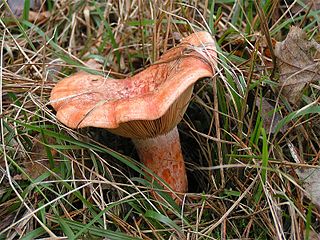
Lactarius deliciosus, commonly known as the delicious milk cap, saffron milk cap and red pine mushroom, is one of the best known members of the large milk-cap genus Lactarius in the order Russulales. It is native to Europe, but has been accidentally introduced to other countries along with pine trees, with which the fungus is symbiotic.

Hericium erinaceus, commonly known as the lion's mane mushroom, yamabushitake, bearded tooth fungus, bearded hedgehog, or old man's beard, is an edible mushroom belonging to the tooth fungus group. Native to North America, Europe, and Asia, it can be identified by its long spines, occurrence on hardwoods, and tendency to grow a single clump of dangling spines. The fruit bodies can be harvested for culinary use.
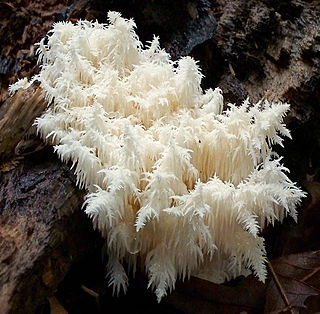
Hericium coralloides is a saprotrophic fungus, commonly known as coral tooth fungus or comb coral mushroom. It grows on dead hardwood trees. The species is edible and good when young, but as it ages the branches and hanging spines become brittle and turn a light shade of yellowish brown.

Hydnellum peckii is a fungus in the genus Hydnellum of the family Bankeraceae. It is a hydnoid species, producing spores on the surface of vertical spines or tooth-like projections that hang from the undersurface of the fruit bodies. It is found in North America, Europe, and was recently discovered in Iran (2008) and Korea (2010). Hydnellum peckii is a mycorrhizal species, and forms mutually beneficial relationships with a variety of coniferous trees, growing on the ground singly, scattered, or in fused masses.
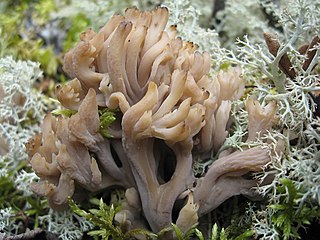
Clavulina cristata, commonly known as the wrinkled coral fungus, white coral fungus or the crested coral fungus, is a white- or light-colored edible coral mushroom present in temperate areas of the Americas and Europe. It is the type species of the genus Clavulina.

Hydnellum caeruleum, commonly known as the blue-gray hydnellum, blue-green hydnellum, blue spine, blue tooth, or bluish tooth, is an inedible fungus found in North America, Europe, and temperate areas of Asia.

Leucoagaricus leucothites, commonly known as the smooth parasol, woman on motorcycle, ma'am on motorcycle, white dapperling, or white agaricus mushroom, is a species of agaric fungus. The species was originally described as Agaricus leucothites by Carlo Vittadini in 1835, and bears similarity to species of that genus. Solomon Wasser transferred it to Leucoagaricus in 1977. While sometimes regarded as edible, the species is suspected of being poisonous due to gastric-upset-causing toxins. It could also be confused with the deadly Amanita ocreata.

Caloscypha is a fungal genus in the family Caloscyphaceae. A monotypic genus, it contains the single species Caloscypha fulgens, commonly known as the snowbank orange peel fungus, spring orange peel fungus, the golden cup, or the dazzling cup. It is a cup fungus, typically up to 4 centimetres in diameter, with a bright to pale orange interior and orange; specimens that are old or bruised often have an olive-green discoloration, especially around the edges.
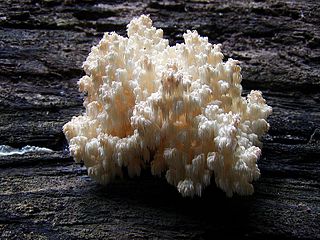
Hericium is a genus of edible mushrooms in the family Hericiaceae. Species in this genus are white and fleshy and grow on dead or dying wood; fruiting bodies resemble a mass of fragile icicle-like spines that are suspended from either a branched supporting framework or from a tough, unbranched cushion of tissue. This distinctive structure has earned Hericium species a variety of common names—monkey's head, lion's mane, and bear's head are examples. Taxonomically, this genus was previously placed within the order Aphyllophorales, but recent molecular studies now place it in the Russulales.
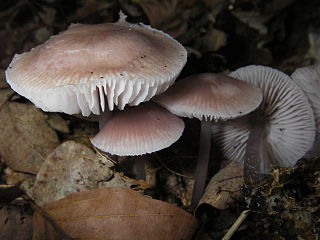
Mycena pura, commonly known as the lilac mycena, lilac bonnet, is a species of mushroom in the family Mycenaceae. First called Agaricus prunus in 1794 by Christian Hendrik Persoon, it was assigned its current name in 1871 by German Paul Kummer. Mycena pura is known to bioaccumulate the element boron.
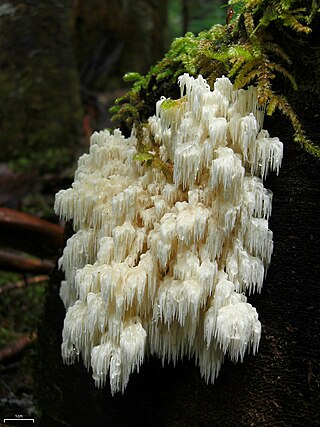
Hericium abietis, commonly known as the bear's head, conifer coral hericium, or western coral hedgehog, is an edible mushroom in the tooth fungus group. It grows on conifer stumps or logs in North America, producing a cream white fruit body up to 10–75 cm (4–30 in) tall and wide. It fruits from after the start of the fall rains to mid-season.

Auriscalpium vulgare, commonly known as the pinecone mushroom, the cone tooth, or the ear-pick fungus, is a species of fungus in the family Auriscalpiaceae of the order Russulales. It was first described in 1753 by Carl Linnaeus, who included it as a member of the tooth fungi genus Hydnum, but British mycologist Samuel Frederick Gray recognized its uniqueness and in 1821 transferred it to the genus Auriscalpium that he created to contain it. The fungus is widely distributed in Europe, Central America, North America, and temperate Asia. Although common, its small size and nondescript colors lead it to be easily overlooked in the pine woods where it grows. A. vulgare is not generally considered edible because of its tough texture, but some historical literature says it used to be consumed in France and Italy.

Galiella rufa, commonly known as the rubber cup, the rufous rubber cup, or the hairy rubber cup, is a species of fungus in the family Sarcosomataceae. It produces cup-shaped fruit bodies with the texture of tough, gelatinous rubber, with a rough, blackish-brown, felt-like outer surface and a smooth reddish-brown inner surface.

Floccularia albolanaripes is a species of fungus in the family Agaricaceae. Mushrooms are characterized by their yellow caps with a brownish center and scales over the margin, and the conspicuous remains of a partial veil that is left on the stipe. The species grows in the Pacific Northwest and the Rocky Mountains of North America, and in India.

Leccinum holopus, commonly known as the white birch bolete, white bog bolete, or ghost bolete, is a species of bolete fungus in the family Boletaceae found in northern Asia, Europe, and northeastern North America. It associates with birch trees and is typically found in boggy or swampy areas, often growing among sphagnum moss.

Hygrophorus chrysodon, commonly known as the flaky waxy cap, or gold flecked woodwax is a species of fungus in the genus Hygrophorus. It is edible but bland in taste. The species is found throughout the Northern Hemisphere.

Hericium cirrhatum is a saprotrophic fungus, commonly known as the tiered tooth fungus or spine face. The species is edible and good eating when young. It has a texture not unlike tender meat or fish. The flesh is cream in colour with an attractive smell when young, but it develops a very unpleasant odour in older specimens.
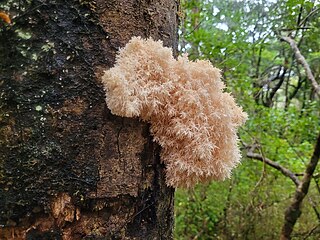
HerIcium novae-zealandiae is a species of fungus in the Hericiaceae family. Formerly classified as Hericium coralloides which shares an almost identical morphology. Being saprotrophic, H. novae-zealandiae can be observed growing from dead, decaying wood. Also known as pekepekekiore, it is endemic to New Zealand and was consumed by indigenous Māori.




















